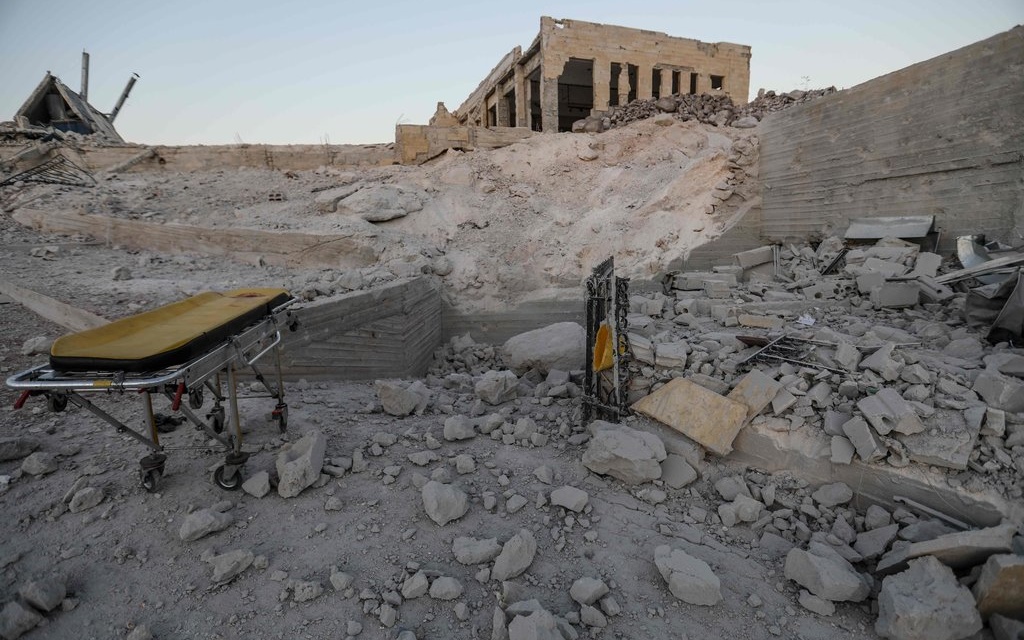Kafr Nabl Hospital in northwest Syria after it was bombed by pro-Assad warplanes, July 2019 (Omar Haj Kadour/AFP/Getty)
The New York Times publishes further documentation of the Russia-regime war on hospitals in opposition areas of Syria.
The Times examines seven attacks that are being investigated by the UN. It concludes that four of the strikes were carried out by the Assad regime’s air force and one by Russia. Responsibility is unclear in one attack, and the seventh — shelling of a medical facility in regime-held northern Hama Province — was by anti-Assad forces .
The assessment is based on witness statements, forensic analysis of photos and videos, weapons identification, satellite imagery, cockpit recordings of Syrian and Russian pilots during bombing missions, and flight logs by Syrian observers.
The regime targets included a child care center in Ariha in Idlib Province. Strikes on July 27 and 28, 2019 killed at least 15 civilians, including several children.
Like many other medical facilities, the center was on a “deconfliction” list. Its coordinates were passed by the UN to the Russian military to ensure it was not attacked.
On July 4, Kafr Nabl Hospital in Idlib Province was bombed again by the regime. The facility had been reopened after previous attacks, including a Russian strike in May. It was struck again by the Russians in November.
See Syria Daily, Nov 16: Documenting Russia’s Bombing of Hospitals and Civilian Areas
Syria Daily, Nov 25: Russia Bombs Another Hospital in Idlib Province
On April 28, the Russian Air Force bombed a hospital set up inside a school compound in the town of Qalaat al-Mudiq in northern Hama Province, soon after the start of a Russia-regime offensive. Staff and patients had been evacuated, preventing casualties.
Eleven days later, regime forces occupied Qalaat al-Mudiq.
On May 3, regime warplanes attacked the Rakaya primary health care center in Idlib Province. Four days later, they struck the center in Kafr Naboudeh.
“Scorched-Earth Policy”
The seven incidents selected by the UN are only a fraction of the attacks attributed to Russia and the regime since their offensive against Idlib and northern Hama began in late April.
The UN reported in November that 61 medical facilities have been attacked, some on multiple occasions, as well as assaults and almost 100 schools, markets, and mosques.
The head of the UN’s humanitarian agency, Mark Lowcock, decried “a bombing campaign aimed at a scorched-earth policy”. Human rights head Michelle Bachelet detailed the “war crimes” and criticized the “failure of leadership by the world’s most powerful nations” with their “collective shrug”.
The strikes echo the tactics used by Russia and the regime in other assaults since Moscow’s military intervention in autumn 2015. Every medical facility in east Aleppo city was attacked in the months-long assault leading to the regime occupation of December 2016. Civilian sites were systematically bombed in East Ghouta, near Damascus, before the area finally surrendered in April 2018.
A worker on aid projects in northwest Syria told EA of the significance of the latest revelations on the extent of the Russia-regime attacks.
Putting a site on a no-strike list without any enforcement mechanism is worse than having no deconfliction list at all.
No accountability will signal acceptance and normalization of a crime to the perpetrators. This is the reason why hospitals and civilian targets are still attacked.
The worker noted that the UN has yet to examine strikes on many of the 29 civilian sites that are on the “deconfliction” list but were still attacked by Russia and the regime.
Dr. Mufaddal Hamadeh, president of the Syrian American Medical Society, echoes the EA source over the limited nature of the UN inquiry, “We don’t think that’s adequate. [These] sites really do not represent the true story.”
Hamadeh noted that UN is not considering November’s attack on a major hospital in Ma’arat al-Num’an in Idlib or the bombing of a camp for displaced person in western Aleppo Province, even though both sites are on the deconfliction list.

